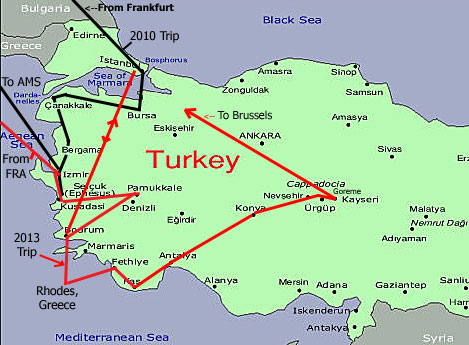Turkey - Perfect for Spring and Early Summer
![]()
Spring in Turkey! Sunny days and few showers make everything verdant and green - flowers bloom, birds nest, folks hanging out in the sidewalk cafes. It's a good time to return to Turkey.
We last visited Turkey in 2010, but chose to leave before seeing what we intended due to the extreme summer heat (over 100F or 38C). At that time, we promised to return and continue our visit when the weather was cooler. 2013 was the year to keep our promise.

On the map at the right the black line shows our 2010 trip, and the red line how we continued our travels in 2013.
On May 1, we flew to Frankfurt, Germany and after an overnight stay continued to Izmir, Turkey We continued to Selcuk by train and checked into the Australia New Zealand Guesthouse feeling immediately at home! This was the place where we had stayed at the end of our last Turkey journey in 2010. Selcuk is a nice small town of nearly 30,000 friendly people, only somewhat impacted by its nearness to Ephesus, one of the most visited sites in Turkey!
During our six day stay, we visited Priene, Miletus, and the Temple of Apollon as well as the hillside village of Sirince, all new for us. We also re-visited Ephesus and the archaeological sites of Isabey Camii, Basilica of Saint John. We still took time to relax and just enjoy the nice weather and pleasant village life.
From Selcuk, we traveled by bus to Pamukkale, the village where mother nature has spilled a white coating of Calcium Carbonate over the hillsides creating bright white travertine deposits and bright blue pools of water. The ancient Phrygians, Greeks and Romans flocked here seeking cures for a range of ailments in the soothing thermal waters. The major features of this site are the baths where people took the waters, the city and the extensive necropolis (cemetery) where those who were not cured were laid to rest. Earthquakes have severely damaged the buildings but the ones that remain were wonderful to see!
From Pamukkale, we traveled by bus south and west to the coast to Bodrum. This is a lovely seaside city whose population jumps from 50,000 in the winter to many times that in the summer! Whew! Thankfully, we arrived before the rush. We visited the Castle of Saint Peter, built by the Knights of Saint John in the 15th century.
We then traveled to Istanbul to spend ten wonderful days with our dear friend, Lora. She was traveling from Gaza and Cairo to return to the USA and made a stopover in Istanbul. We savored days of exploring the city and just sitting in cafes to talk, sharing stories and ideas. After seeing Lora off to the US, we returned to Bodrum for a few more days.
The Greek island of Rhodes was our next stop, a three hour hydrofoil ride away. Rhodes Old Town was the main attraction, a medieval walled city built by the Knights of Saint John in the 1400s.
Our return to Turkey took us to Fethiye where we cruised on the deep blue waters around the islands and walked the bright white sand beaches. We then moved on to Kas, further east along the Mediterranean coast. It's smaller, with a nice harbor enjoyed by the yachting folks, but also a good base camp to visit the ancient sites of Xanthos, and the now underwater city of Kekova.
Another bus ride took us to Antalya, a larger modern city surrounding a harbour and charming old city on the cliffs above. We stayed in a renovated Ottoman era house, now functioning as a comfy pension. We visited the Museum of Archaeology and the site of the ancient city of Perge.
From Antalya, we traveled by bus into the heart of Anatolia, the city of Konya. Here, we visited the Mevlana Museum where we viewed the tomb of the great Turkish thinker and mystic philosopher Mevlana Celaleddin Rumi who founded the Sufi sect of Islam who practice a ritual ceremony known as the 'whirling dervish'. We encountered dozens of Muslim pilgrims who had gathered to pay their respects to the memory of this great man.
We continued east by another bus to Goreme. This smaller and more touristy town is the heart of Cappadocia, perhaps the most famous region of Turkey. The landscape was shaped by erosion of the volcanic tuff and basalt that had been deposited by the eruptions of three volcanoes millions of years ago. The resulting "fairy chimneys" similar to the 'tent rocks' in New Mexico, were, in more modern times (from 1700 BC), carved out to create homes and churches and even large underground cities once housing 1000s of people.. Today, many of the cave homes have become hotels and tourists flock here.
By now, the summer heat had arrived, as expected. We had seen most of what we had hoped to see. So we booked a flight to Brussels, our next home.
Click here to view our story about the amazing archeological sites we visited in our travels in Turkey.
Click here to read about our travels for the rest of the summer in Europe.
Click here to return to our 'Searching the World for People Friendly Cities' page
![]()